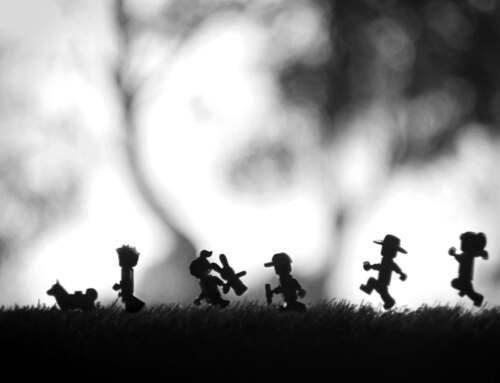I love numbers
Did you know 2 and 5 are the only prime numbers that end with a 2 or a 5?
And did you know, 40 when written “forty” is the only number with letters in alphabetical order, while “one” is the only one with letters in reverse order when written in English? And “four” is the only number in the English language that is spelt with the same number of letters as the number itself?
I love maths
111,111,111 × 111,111,111 = 12,345,678,987,654,321. In fact, multiplying ones will always give you a palindromic result. 11 x 11 = 121
Maths and palindromes? So many dynamos! *read that backwards
I even love math rock bands like Nomeansno and Shellac, and mathcore bands like The Dillinger Escape Plan and The Locust.
Yep, I’m a delight be have a beer with! I’ll bore you with numbers facts whilst The Locust blast their complex, aggressive weirdness from the stereo.
A week of number fun
This past week has been an intriguing one regrading numbers.
On Monday LEGO shared an image of mine on their social media channels, Instagram, Facebook and Twitter.
The featured posts collected 34k Instagram likes, 1.6k Facebook likes and 512 Twitter likes in the first 24 hours.
And what did all these numbers mean for my numbers?
In the 24 hours following I amassed a total of 78 more Instagram followers. Sure, this number doesn’t take into account the average daily follower losses I’ve experienced since the algorithm screwed things up and I renounced my Instagram allegiance.
This is a picture
Of things going a little out of hand.
This is a sculpture
Of a couple of things we gotta get straight
Shellac – This Is A Picture
I’m not disparaging my appreciation that LEGO chose to share one of my photos. Not at all! I’m incredibly grateful that LEGO wanted to share my junk. I’m not questioning the gesture; it’s the platform on which it occurred I’m questioning.
As someone who loves numbers I was curious to explore these numbers a little more.
I remember when LEGO followed me on Instagram in 2014. I woke that morning and thought something was broken; overnight my follower count had exploded. Yet, now LEGO share a photo of mine and the impact on my account is barely noticeable.
Coincidentally, on the same day last week Google+ promoted my account in their G+ Create community. This feature resulted in 30 new followers.
Let’s look at some numbers. Yay!
An Instagram account with 2.3million followers shares my photo and I end up with a percentage gain of 0.26%.
(30030 – 29952) / 29952 x 100 = 0.26
Google+ feature me in a community of 730 members and the result is a 14.6% gain in followers.
(227 – 198) / 198 x 100 = 14.6
And what percentage of those community’s members or followers chose to pursue the features? Well, 4.11% of the G+ community, compared with 0.003% from Instagram.
(30 / 730) x 100 = 4.11%
(78 / 2300000) x 100 = 0.003%
Yeah, I get that the number changes on these days may have been shaped from outside these two events. And yes, I get that there may have been fluctuations in these numbers that weren’t direct result of the features. I understand that the mathematical outcomes aren’t purely the result of the features I’ve mentioned. And yeah, I get that lower base numbers require lower number additions or subtractions to impact on the results proportionately.
Out with the old.
This is the new.
The minor details have been overlooked.
Plastic people making plastic trees grow out of concrete,
This landscape lacks intellectual quality.
Emergency.
The Locust – Stucco Obelisiks Labelled as Trees
If it ain’t broke, don’t fix it
However, I still say that these numbers illustrate how broken Instagram is now. I’d argue that the gap between the numbers from these two platforms wouldn’t have been so great a few years ago. In fact, the Instagram numbers would’ve overshadowed those from G+. But they don’t now!

Broken Clown
When a new following, that’s only discovered by a user checking through a following list or checking through the activity of those they follow, results in a bigger gain than a feature in a feed, something doesn’t compute. Perhaps it’s because that post is now buried below advertising, stories and the algorithm, requiring greater digging to unearth than mining through the activities of a feed you follow?
When a community of 730 is alerted to someone, and it results in 30 new followers, whereas an account with 2.3 million followers results in 78, those maths don’t add up. No matter what type of trickery I try to apply!
I’ve never made a fuss about follower numbers. I truly appreciate those that do follow, but it’s not why I do what I do, or why I started.
This post is neither a gloat nor a grumble; it’s just some curious maths!
– Brett
If you’ve made through all my blathering and ended up here, you should sign up to our weekly email round up where you’ll get a recap of all the babbling from the week.
And while you’re doing things, you should definitely join our G+ Community where we hold monthly contests with prizes and lots of other cool stuff too.







We can’t look beyond the idea that how instagram users interact with Instagram has also changed. In mentioning in the past the numbers on Instagram (percentage wise) would like have eclipsed those from G+. That’s likely because we used to be more easily engaged there. Our community was smaller and more niche. Now, seemingly, everyone in the known world is on instagram, we’re obliged to follow our friends and family and their stuff is flooding our feeds and hiding the things we first came to IG to see.
Further, Facebook now influences our IG feed and further confounds us.
The worst thing they ever did was remove the chronological feed for their stupid algorithm, it really messed everything up. They also seemed to make the pictures bigger and moved away from the interaction. This is also the failing of Flickr, making the image take over the whole screen practically hiding the community aspects, leading to lower interaction beyond the double-tap to like.
We’re also conditioned on Instagram to double-tap, scroll, double-tap, scroll… it’s likely few read the caption and fewer still leave a comment.
The numbers in your final query do kind of add up if you delve into the engagement of the two accounts in question. Of the 2.3 million followers how many are regularly liking the posts from that brand, and how many comments are being left, compared to the account with 730. Likely the community of 730 has a much higher engagement. A new follower doesn’t count for much if they aren’t also liking and commenting.
On my model photography IG account I get a tonne of new followers every day, but very little interaction beyond the follow, and a large majority of those new followers drop off shortly after the follow, there seems to be a follow for follow mentality on IG and they follow you, so you’ll follow them and then they will unfollow you to keep their follower vs follow ratio high in hope of becoming an “influencer”.
I enjoyed your travel around math-land, but feel to answer the questions about the numbers on social media one must delve deeper than followers and into the numbers of engagement.
I couldn’t agree more James!
I do wonder if they way users interact with Instagram is a result of the changes that have occurred at the platform level, or the platform has changed to accommodate the changes of its users? Either way, the lack of interaction and engagement is a massive a downfall in the current iteration.
I know I’ve dropped off interacting, and that’s partly due to ‘missing’ post buried below advertising, the algorithm and stories. The time spent ‘chasing’ posts from those I follow becomes laborious!
‘A new follower doesn’t count for much if they aren’t also liking and commenting.’ This rings so true! Unless of course your motivation for participating is purely to gain followers? Which, as you point out, in the F4F world is the sadly the case for many.
Perhaps my next delve into the world of social media maths might have to revolve around interaction and engagement?
Instagrams whole model is now based on Facebooks model. Basically charge the content creator in order to share their content to more people. This is obviously a model that works for them and effectively monetizes the platform for investors. As you mentioned the numbers don’t add up – that’s because for numbers to add up they want some moola. Basically it is a business model of rewarding those who pay the most by giving them the praise they crave, rather than the content. Even if your content is awesome – if you don’t pay, not very many people see it. Google on the other hand tends to reward the content creator (YouTube). If you create awesome content it starts to get noticed and then you can monetize it with ads – google charges businesses to advertise on quality content. So as content creators – Google+ really is a no-brainer. It’s two different models that both seem to work well, but I am currently leaning towards G+.
Oh it’s all business Joe!
I knowa mate that experimented with the “pay for promotion” to see what the number results for doing so were. He was completely underwhelmed by the “bang for his buck”!
I also saw his advertisement promoting his account in my feed, which led me to ask about it. Not a great investment of funds, being promoted in feeds of those who already follow you?
I’d also add that when sharing photos for fun turns into an exercise of self-promotion to drive numbers, that also underlines the model the platform is striving for. As the algorithm pushes posts down feeds into the nether regions, users turn to stories to alert their followers to new posts. It’s this “those who promote themselves thrive” model that also smacks of “business rather than pleasure”!
Ok, I stopped reading after “math-rock” bands and math-core monster. We share the same love for this kind of music! ?
OK, back to reading.
Ok, here I am again. I think people are basically lazy. If they see a featured picture they double tap it, but they won’t go to the original picture, even if the author is mentioned. It requires some sort of empathy: oh, nice photo, I think that it deserves for like on author’s feed. And nowadays social media consuments don’t want to get tired by searching for original photos. I experienced it by myself, when an account, which share other’s stuff, featured my photo. It had more likes than my original photo and only few people decided to visit my account and like the photo.
People are lazy.
Yay to math rock and math-core!!
Yes, people are lazy. I’ve discovered so many great toy photographers through features. It’s a shame that the “double tap and scroll on” mentality means so many are missing out on discovering so much!
I completely agree with you about posts getting buried. I see some wonderful and creative photos on IG but they get lost among my confusing feed, by “confusing” I mean not chronological and also full of ads. Correct me if I’m wrong, but IG doesn’t have a way to sort your followers? On Flickr, I can mark people as “Friends”, “Family” and then other contacts. This way I can look at Friends and Family first and then look at the rest of my contacts’ photos (in chronological order). It makes it much easier to keep up with people.
The other problem I have with IG (and it might be just me) is that doesn’t work well on my desktop but I don’t like trying to view someone’s photo on a tiny phone screen (I guess I’m getting old). Typing comments on my phone is even worse, so I’m much more likely to just “like” it and think “I’ll write a comment when I get back to my computer”. My intentions are good but I rarely ever remember to go back and leave a comment.
Congratulations on LEGO featuring your photo! I saw it on Facebook but I never saw it on IG. It must have been buried in my algorithm driven feed 🙂
Lynn
Thanks Lynn.
I’d never thought of the laptop v. mobile thing?
I do use G+ on my laptop more than I do on my phone though. That’s probably because I’ve got more to say about the photos shared there. And that’s probably because the “double-tap, scroll, repeat” has rubbed off on me. It’s difficult to muster the energy to comment when others don’t.
It’s funny that you saw the LEGO feature on Facebook but not IG. Case closed!
Great post, Brett! I have to admit that maths was never my best subject, and sometimes working with numbers can be a bit overwhelming. You did an excellent job of breaking it all down and making it understandable/interesting though! Now I’m contemplating how my own engagement percentages vary from platform to platform…
I’m in the same boat as Lynn; I’m often frustrated and hindered somewhat by Instagram being a mobile-focused platform. I don’t like having to type on my phone, so I too think “I’ll go back through and comment later!” in terms of both commenting on other people’s photos, and responding to comments on my own. I usually forget though, or don’t get to it for several days.
I couldn’t agree more with what you and James said above about Instagram’s “click-scroll-repeat” system. I constantly try to keep myself from falling into that pattern. And when I see someone’s photo featured on a different account (be it LEGO or one of the various “toy syndicates” or “top toy photos” accounts) I make sure to not just like that post, but like it on the original person’s feed as well to show my support and maybe give them a follow if I like their stuff.
Unfortunately, it does all boil down people being lazy. While I can try to keep myself from being lazy on the platform, the vast majority of people won’t. And on top of that, IG itself makes it extremely hard on the user to use the platform effectively. Over the last few months I’ve definitely fallen in love with G+, and your math breakdown only proves that I made the right decision.
If you need someone to help you with maths…I love it!
And yes, I’m a victim of the “click-scroll-repeat” mentality too. When I have to wade through ads, stories and post from all over the shop, I’m too beat to type something meaningful. Plus it’s hard to be an advocate for fostering conversations on a platform where others aren’t.
And that’s where G+ truly excels. I’ve rarely commented on a post without it getting a response. Sometimes those comments and replies develop into conversations, and sometimes others join in. The sense of community is tangible!